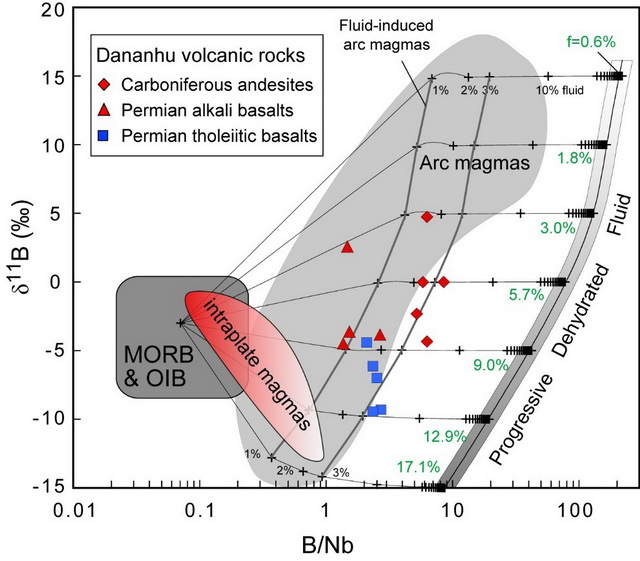Identifying tectonic setting is one of the most important aspects of geological research. However, traditional method is problematic in identifying emplacement tectonic setting of magmas which are metasomatized by subduction-related fluids. A new method to conquer this deficiency is badly needed. Important progress is made in identifying tectonic setting of the Central Asian Orogenic Belt (CAOB) during Permian by utilization of Boron isotopes by researchers from Guangzhou Institute of Geochemistry, Chinese Academy of Sciences.
The CAOB, situated between the Siberian Craton in the north and the North China-Tarim Craton in the south, began its crustal growth at ca. 1000 Ma, which continued to the Late Carboniferous or c. 250 Ma. However, the tectonic setting of the Permian CAOB remains controversial, with several competing models. These include continuous southward accretion between the Siberian and Tarim cratons until the Triassic, post-collisional extension, and plume activity in the CAOB during the Permian.
Previous conclusions regarding the tectonics of the Permian CAOB mainly derive from geochemical and traditional isotopic studies on Permian igneous rocks. The problem associated with these approaches is that the CAOB has experienced multiple stages of oceanic subduction during the Paleozoic, and slab-derived fluids/melts might have reset chemical characteristics of the overriding mantle wedge or even the asthenosphere. Therefore, traditiona l trace element discrimination methods would yield ambiguous tectonic constraints on post-subduction magmas.
Boron is an excellent tracer of oceanic crust recycling and is widely used for the study of igneous rocks emplaced in subduction and intraplate settings. Combined with trace element ratios such as B/Nb, boron isotopic composition can help distinguish intraplate magmas from arc magmas. Slab-derived fluids are initially rich in B and have elevated δ11B values because fluids preferentially mobilize B, especially 11B in low-temperature environment. This explains why arc volcanic rocks are gradually depleted in B and 11B during the course of slab subduction. This interpretation is supported by B isotopic studies on arc volcanic rocks world-widely. All the arc magmas exhibit positive correlation between B/Nb and δ11B, consistent with partial melting of mantle wedge with involvement of progressive dehydrated fluids in the source. In contrast, intraplate magmas are characterized by a negative correlation of B/Nb vs. δ11B given by the gradual decrease of B/Nb ratios and increase of δ11B values (Fig. 1).

Figure 1 δ11B - B/Nb diagram identifying emplacement tectonic environment of Dananhu Carboniferous-Permian volcanic rocks (Image by LIU Haiquan
Researchers from the Guangzhou Institute of Geochemistry, Chinese Academy of Sciences, carried out a geochemical study on Carboniferous-Permian volcanics from Dananhu section, Tuha basin, southwestern CAOB. 40Ar/39Ar analyses for feldspar separates yield a Carboniferous age of 321.2±9.8 Ma for the andesites and a Permian age of 278.9±4.2 Ma for the basalts. Both the andesites and basalts geochemically resemble subduction-related magmas in aspects of their trace element and Sr-Nd-Pb isotopic composition, but they may differ in petrogenesis. Positive correlation between B/Nb ratios and δ11B values suggest that the Carboniferous andesites were generated by interaction between slab-derived melts/fluids and the mantle wedge (Fig. 1). Negative correlation between B/Nb and δ11B for the Permian basalts imply that the arc signatures were imposed by previous subduction events, and no direct slab-derived fluids/melts participated in their petrogenesis (Fig. 1). These geochemical characteristics alongside regional geologic records collectively suggest a tectonic shift in the southwestern CAOB from subduction-related setting during the Late Carboniferous to an intraplate setting during the Early Permian. A mantle plume may have been responsible for the Permian basalts in the East Tianshan.
This research is accomplished by Doctor LIU Haiquan under the guidance of Professor XU Yigang from Guangzhou Institute of Geochemistry, Chinese Academy of Sciences. This research was supported by research grants from the Strategic Priority Research Program (B) of Chinese Academy of Sciences (XDB18030604) and National Basic Research Program of China (2011CB808906).
Liu, H.-Q., Xu, Y.-G., Wei, G.-J., Wei, J.-X., Yang, F., Chen, X.-Y., Liu, L., and Wei, X., 2016. B isotopes of Carboniferous-Permian volcanic rocks in the Tuha basin mirror a transition from subduction to intraplate setting in Central Asian Orogenic Belt. Journal of Geophysical Research: Solid Earth, 121(11): 7946-7964.
http://onlinelibrary.wiley.com/doi/10.1002/2016JB013288/full